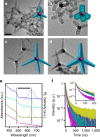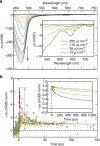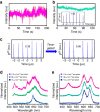Using shape to turn off blinking for two-colour multiexciton emission in CdSe/CdS tetrapods
- PMID: 28497776
- PMCID: PMC5437295
- DOI: 10.1038/ncomms15083
Using shape to turn off blinking for two-colour multiexciton emission in CdSe/CdS tetrapods
Abstract
Semiconductor nanostructures capable of emitting from two excited states and thereby of producing two photoluminescence colours are of fundamental and potential technological significance. In this limited class of nanocrystals, CdSe/CdS core/arm tetrapods exhibit the unusual trait of two-colour (red and green) multiexcitonic emission, with green emission from the CdS arms emerging only at high excitation fluences. Here we show that by synthetic shape-tuning, both this multi-colour emission process, and blinking and photobleaching behaviours of single tetrapods can be controlled. Specifically, we find that the properties of dual emission and single-nanostructure photostability depend on different structural parameters-arm length and arm diameter, respectively-but that both properties can be realized in the same nanostructure. Furthermore, based on results of correlated photoluminescence and transient absorption measurements, we conclude that hole-trap filling in the arms and partial state-filling in the core are necessary preconditions for the observation of multiexciton multi-colour emission.
Conflict of interest statement
The authors declare no competing financial interests.
Figures






Similar articles
-
Efficient color-tunable multiexcitonic dual wavelength emission from Type II semiconductor tetrapods.ACS Nano. 2014 Sep 23;8(9):9349-57. doi: 10.1021/nn503343c. Epub 2014 Sep 3. ACS Nano. 2014. PMID: 25153534
-
Dual wavelength electroluminescence from CdSe/CdS tetrapods.ACS Nano. 2014 Mar 25;8(3):2873-9. doi: 10.1021/nn500030t. Epub 2014 Mar 4. ACS Nano. 2014. PMID: 24559396
-
The role of particle morphology in interfacial energy transfer in CdSe/CdS heterostructure nanocrystals.Science. 2010 Dec 3;330(6009):1371-4. doi: 10.1126/science.1198070. Science. 2010. PMID: 21127250
-
Effect of Core/Shell Interface on Carrier Dynamics and Optical Gain Properties of Dual-Color Emitting CdSe/CdS Nanocrystals.ACS Nano. 2016 Jul 26;10(7):6877-87. doi: 10.1021/acsnano.6b02635. Epub 2016 Jun 22. ACS Nano. 2016. PMID: 27276033
-
Origin and control of blinking in quantum dots.Nat Nanotechnol. 2016 Aug 3;11(8):661-71. doi: 10.1038/nnano.2016.140. Nat Nanotechnol. 2016. PMID: 27485584 Review.
Cited by
-
Semiconductor Nanocrystals for Biological Imaging and Fluorescence Spectroscopy.Adv Exp Med Biol. 2021;1310:449-473. doi: 10.1007/978-981-33-6064-8_16. Adv Exp Med Biol. 2021. PMID: 33834445
-
From Inside Out: How the Buried Interface, Shell Defects, and Surface Chemistry Conspire to Determine Optical Performance in Nonblinking Giant Quantum Dots.Small Sci. 2023 Oct 10;3(11):2300092. doi: 10.1002/smsc.202300092. eCollection 2023 Nov. Small Sci. 2023. PMID: 40213516 Free PMC article.
-
Near-Infrared-Emitting CuInS2/ZnS Dot-in-Rod Colloidal Heteronanorods by Seeded Growth.J Am Chem Soc. 2018 May 2;140(17):5755-5763. doi: 10.1021/jacs.8b01412. Epub 2018 Mar 29. J Am Chem Soc. 2018. PMID: 29569443 Free PMC article.
-
Rational Design of Multi-Color-Emissive Carbon Dots in a Single Reaction System by Hydrothermal.Adv Sci (Weinh). 2020 Nov 23;8(1):2001453. doi: 10.1002/advs.202001453. eCollection 2020 Jan. Adv Sci (Weinh). 2020. PMID: 33437569 Free PMC article.
-
Shell thickness dependent photostability studies of green-emitting "Giant" quantum dots.Nanoscale Adv. 2021 Sep 24;3(24):6984-6991. doi: 10.1039/d1na00663k. eCollection 2021 Dec 7. Nanoscale Adv. 2021. PMID: 36132372 Free PMC article.
References
-
- Talapin D. V. et al.. Seeded growth of highly luminescent CdSe/CdS nanoheterostructures with rod and tetrapod morphologies. Nano Lett. 7, 2951–2959 (2007). - PubMed
-
- Liao Y., Xing G., Mishra N., Sum T. C. & Chan Y. Low threshold, amplified spontaneous emission from core-seeded semiconductor nanotetrapods incorporated into a Sol–Gel matrix. Adv. Mater. 24, OP159–OP164 (2012). - PubMed
-
- Vlaskin V. A., Janssen N., van Rijssel J., Beaulac R. & Gamelin D. R. Tunable dual emission in doped semiconductor nanocrystals. Nano Lett. 10, 3670–3674 (2010). - PubMed
-
- McLaurin E. J., Bradshaw L. R. & Gamelin D. R. Dual-emitting nanoscale temperature sensors. Chem. Mater. 25, 1283–1292 (2013).
Publication types
LinkOut - more resources
Full Text Sources
Other Literature Sources

